

English Reformation. The English Reformation was a series of events in 16th century England by which the Church of England broke away from the authority of the Pope and the Catholic Church.
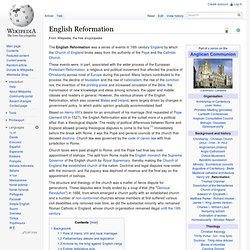
These events were, in part, associated with the wider process of the European Protestant Reformation, a religious and political movement that affected the practice of Christianity across most of Europe during this period. Many factors contributed to the process: the decline of feudalism and the rise of nationalism, the rise of the common law, the invention of the printing press and increased circulation of the Bible, the transmission of new knowledge and ideas among scholars, the upper and middle classes and readers in general. However, the various phases of the English Reformation, which also covered Wales and Ireland, were largely driven by changes in government policy, to which public opinion gradually accommodated itself. Church taxes were paid straight to Rome, and the Pope had final say over appointment of bishops. Music and the Counter Reformation. Time Line Renaisaance and reformation 1440-1648. Church History Timeline: 1500-1599 - The Reformation. The Five Solas of the Reformation The following are the foundational principles of the Reformation, written as a corporate confession by Rev.
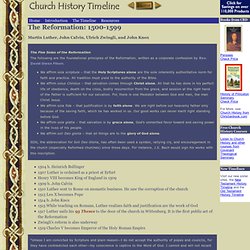
David Owen Filson. We affirm sola scriptura – that the Holy Scriptures alone are the sole inherently authoritative norm for faith and practice. All tradition must yield to the authority of the Bible. We affirm solus Christus – that salvation comes through Christ alone. SDG, the abbreviation for Soli Deo Gloria, has often been used a symbol, rallying cry, and encouragement in the church (especially Reformed churches) since those days. 1504 b. “Unless I am convicted by Scripture and plain reason—I do not accept the authority of popes and councils, for they have contradicted each other—my conscience is captive to the Word of God. Luther before the Diet of Worms, April 17, 1521. And now for something completely different... 1521 Luther is excommunicated 1525 The Bondage of the Will.
Buy these books from Christian Book Distributors For further study. History - An Overview of the Reformation. The Counter-Reformation. The subject will be considered under the following heads: I.
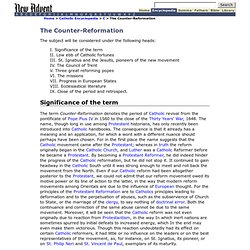
Significance of the term II. Low ebb of Catholic fortunes III. St. Catholic counter reformation. Counter-Reformation. A copy of the Vulgate (the Latin edition of the Catholic Bible) printed in 1590, after many of the Council's reforms had begun to take place in Catholic worship.
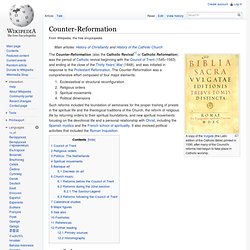
The Counter-Reformation (also the Catholic Revival[1] or Catholic Reformation) was the period of Catholic revival beginning with the Council of Trent (1545–1563) and ending at the close of the Thirty Years' War (1648), and was initiated in response to the Protestant Reformation. The Counter-Reformation was a comprehensive effort composed of four major elements: Ecclesiastical or structural reconfigurationReligious ordersSpiritual movementsPolitical dimensions Council of Trent[edit] A session of the Council of Trent, from an engraving.
Pope Paul III (1534–1549) initiated the Council of Trent (1545–1563), a commission of cardinals tasked with institutional reform, addressing contentious issues such as corrupt bishops and priests, indulgences, and other financial abuses. Religious orders[edit] Protestant Reformation. Although the core motivation behind these changes was theological, many other factors played a part, including the rise of nationalism, the Western Schism which eroded people's faith in the Papacy, the corruption of the Curia, and the new learning of the Renaissance which questioned much traditional thought.

On a technological level the invention of the printing press proved extremely significant in that it provided the means for the rapid dissemination of new ideas. The Roman Catholic Church responded with a Counter-Reformation initiated by the Council of Trent and spearheaded by the new order of the Society of Jesus (Jesuits) specifically organized to counter the Protestant movement. In general, Northern Europe, with the exception of most of Ireland, turned Protestant. Southern Europe remained Roman Catholic, while Central Europe was a site of fierce conflict, escalating to full-scale war. Religious situation in Europe[edit] History and origins[edit] Earlier schisms[edit] Literacy[edit]
THE REFORMATION AND COUNTER-REFO. By James Jackson Background At the beginning of the sixteenth century, the Catholic church, modeled upon the bureaucratic structure of the Holy Roman Empire, had become extremely powerful, but internally corrupt.
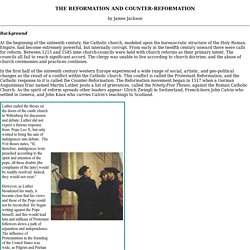
From early in the twelfth century onward there were calls for reform. Between 1215 and 1545 nine church-councils were held with church reforms as their primary intent. The councils all fail to reach significant accord.